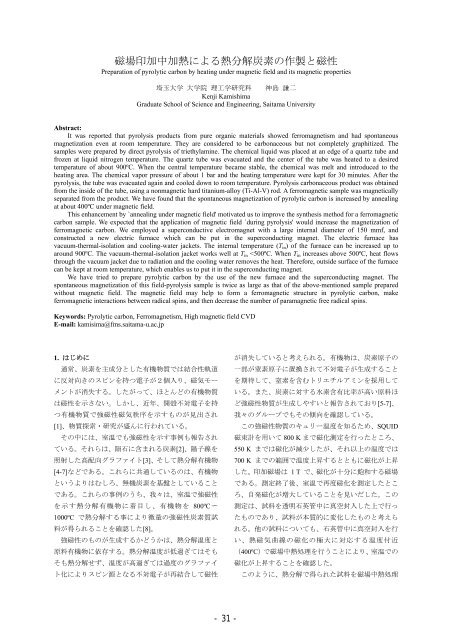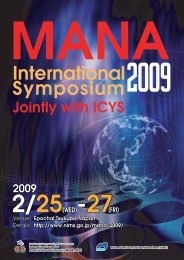物質・材料研究機 共用基盤部門 強磁場共用ステーション 2008 年度 ...
物質・材料研究機 共用基盤部門 強磁場共用ステーション 2008 年度 ...
物質・材料研究機 共用基盤部門 強磁場共用ステーション 2008 年度 ...
Create successful ePaper yourself
Turn your PDF publications into a flip-book with our unique Google optimized e-Paper software.
磁 場 印 加 中 加 熱 による 熱 分 解 炭 素 の 作 製 と 磁 性<br />
Preparation of pyrolytic carbon by heating under magnetic field and its magnetic properties<br />
埼 玉 大 学 大 学 院 理 工 学 研 究 科 神 島 謙 二<br />
Kenji Kamishima<br />
Graduate School of Science and Engineering, Saitama University<br />
Abstract:<br />
It was reported that pyrolysis products from pure organic materials showed ferromagnetism and had spontaneous<br />
magnetization even at room temperature. They are considered to be carbonaceous but not completely graphitized. The<br />
samples were prepared by direct pyrolysis of triethylamine. The chemical liquid was placed at an edge of a quartz tube and<br />
frozen at liquid nitrogen temperature. The quartz tube was evacuated and the center of the tube was heated to a desired<br />
temperature of about 900ºC. When the central temperature became stable, the chemical was melt and introduced to the<br />
heating area. The chemical vapor pressure of about 1 bar and the heating temperature were kept for 30 minutes. After the<br />
pyrolysis, the tube was evacuated again and cooled down to room temperature. Pyrolysis carbonaceous product was obtained<br />
from the inside of the tube, using a nonmagnetic hard titanium-alloy (Ti-Al-V) rod. A ferromagnetic sample was magnetically<br />
separated from the product. We have found that the spontaneous magnetization of pyrolytic carbon is increased by annealing<br />
at about 400ºC under magnetic field.<br />
This enhancement by `annealing under magnetic field' motivated us to improve the synthesis method for a ferromagnetic<br />
carbon sample. We expected that the application of magnetic field `during pyrolysis' would increase the magnetization of<br />
ferromagnetic carbon. We employed a superconductive electromagnet with a large internal diameter of 150 mmf, and<br />
constructed a new electric furnace which can be put in the superconducting magnet. The electric furnace has<br />
vacuum-thermal-isolation and cooling-water jackets. The internal temperature (T in ) of the furnace can be increased up to<br />
around 900ºC. The vacuum-thermal-isolation jacket works well at T in















